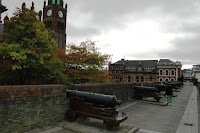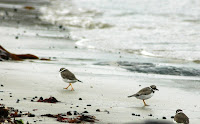
The town is set on the River Foyle, from where many ships took emigrants to USA around 1900. The 1933 Craigavon bridge has two levels, originally taking trains on one level, but cars use both levels now since 1965 when the railways were pruned back.

Derry is the best preserved fully-walled city in Ireland. The city dates from 546 AD, in the time of St Columb, and had a large cathedral, the Teample Mor, but by 1600 it was in ruins. In 1566 Elizabeth I sent an English garrison to fortify the town and in 1610 King James I founded a colony for plantation of English and Scottish settlers.
There have been several sieges of the town, particularly in 1688 when the 13 apprentice boys shut the gates and walled in thousands of Protestants, defending themselves against the Catholic forces of King James II. An estimated quarter of the 30,000 inhabitants died but the siege was broken whan a ship arrived with support.


This is St Columb Cathedral and the mound and monument to the 13 apprentices. The church has a small musuem, including a large 274 pound cannonball that was fired into the city with a message inside in 1688. 'Read this!'

The repercussions of that siege still ring around this divided city, where the controlling Protestants live uneasily with the Catholics. Even the town name is disputed, with the Protestants and the road signs showing Londonderry and the Catholics using the name Derry. We walked around the city wall, about 1.5 kilometres and took these pictures.





The Catholics tend to live on 'Bogside', which has been the scene of many riots and 'Bloody Sunday' in 1972 when the English forces opened fire on unarmed Catholic civil rights marchers, killing 13.

Here are the Protestant messages to those walking on the wall. Look at the red-white-blue kerbs that we also see where we are staying in Country Antrim generally beside an Orange Hall. It's all very in-your-face.


The words in the first picture refer to the hunger strike of civil rights protesters imprisoned without trial in 1981 including the death of MP
Bobby Sands.




There are 11 murals on Bogside which can't help arousing emotions. We didn't have the courage to walk in Bogside, with our wrong accents and wrong surname.
It was probably the most interesting town we have visited.

























































